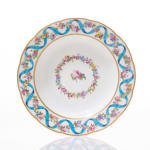Sèvres Porcelain
H.1 5/8 Dia.9 5/8 in
Further images
Literature
Factory marks in blue enclosing the date letter r for 1770 and painter's mark 6 for Bertrand (active at Sèvres from 1757-75).
Shortly after Madame du Barry became Louis XV’s mistress, she purchased a dinner service of this ‘rubans bleu céleste’ pattern from the Sèvres factory. It was purchased from the porcelain factory on her behalf through her banker Jean-Baptiste Buffault in December 1769 [Peters 69-9].
During 1770 more service wares decorated with ‘rubans bleu céleste’ were sold to Madame du Barry directly. The original service had no soup plates but in December 1770 Buffault paid the factory for more pieces of this pattern including 30 soup plates costing 42 livres each [Peters 70-8] and as that is the year for which this plate is dated, we propose that this plate comes from that delivery.
Another service of this pattern was sold in 1770 to an intermediary for the Earl of Carlisle of Castle Howard, but it had no soup plates in the 1770 delivery. There is a record for this service of soup plates and other pieces being supplied in a supplement in 1773 and that service is known today with its soup plates dated for 1773 amongst other pieces all matching their original delivery lists dated for 1770.
Soup plates of this pattern dated 1770 are therefore regarded as being supplied to Madame du Barry. There is a further twist to their provenance which starts with a record in the Bibliothèque Nationale in Paris where a list of Madame du Barry's purchases of Sèvres porcelain between 1771-74 notes that this service was sold by '...sieur Bufau, pour l'Angleterre'.
The recently retired Chief Curator of the National Gallery of Wales, Dr. Oliver Fairclough has researched and explained the subsequent history of Madame du Barry's Sèvres service with ‘rubans bleu céleste’ decoration. Du Barry's banker Buffault arranged its' sale to Sir Watkin Williams-Wynn (1749-89) and notably wealthy landowner and sophisticated art collector who also commissioned paintings from celebrated artists such as Batoni and Reynolds as well as building a house in London with the architect Robert Adam who also designed various of its' contents. His main home was in north Wales with extensive properties ranging across Wales and into England bringing him exceptional income and therefore his ability to form outstanding collections.
Thanks to Sir William owning Madame du Barry's Sèvres service the pattern was even copied in the very early 19th century by the Nantgarw porcelain factory in Wales.
The Sèvres service was at the Robert Adam-designed Wynn House, 20 St. James's Square, London by 1888 if not before, and is listed in an inventory of 1906 which identifies the 1769-70 date letters on these pieces. The service remained in the Watkins-Wynn family until the 1950s. Later a major part of it was sold at Sotheby's, London in November 1985 and the same selection again at Sotheby's, Zurich, December 1991.
The reason for Madme du Barry selling her Sèvres service with ‘rubans bleu céleste’ is that in 1770 she ordered another large Sèvres service decorated with her initials DB which was completed in August 1771. Therefore Buffault must have been tasked with the sale of this first Sèvres service.
A large group of this service is in a British private collection and pieces are in the Musée des Arts Décoratifs, Paris, the Musée des Beaux-Arts, Boulogne-sur-Mer and in many other private collections noteably a group collected by the Museum of the Châteaux of Versailles and nowadays displayed in a cupboard in one of du Barry's recently restored rooms.
Interestingly the pattern was also sold to other English collectors, the Duke of Dorset had a service made during 1769-70 at Knole in Kent and the Earl of Egremont had pieces made during 1773-74 at Petworth House, Sussex. The Knole service did not have soup plates and the Petworth service was made later than this plate is dated.









